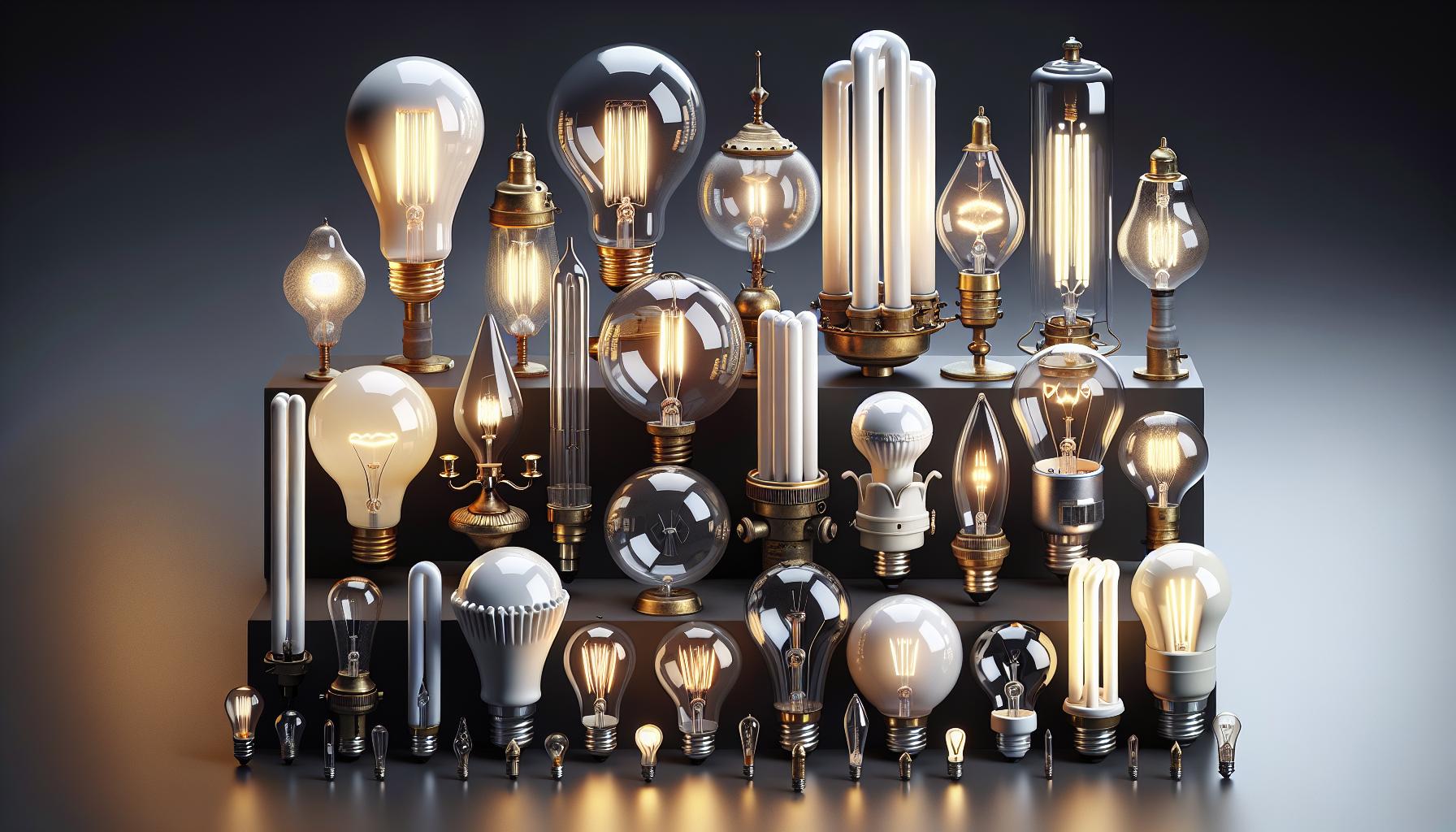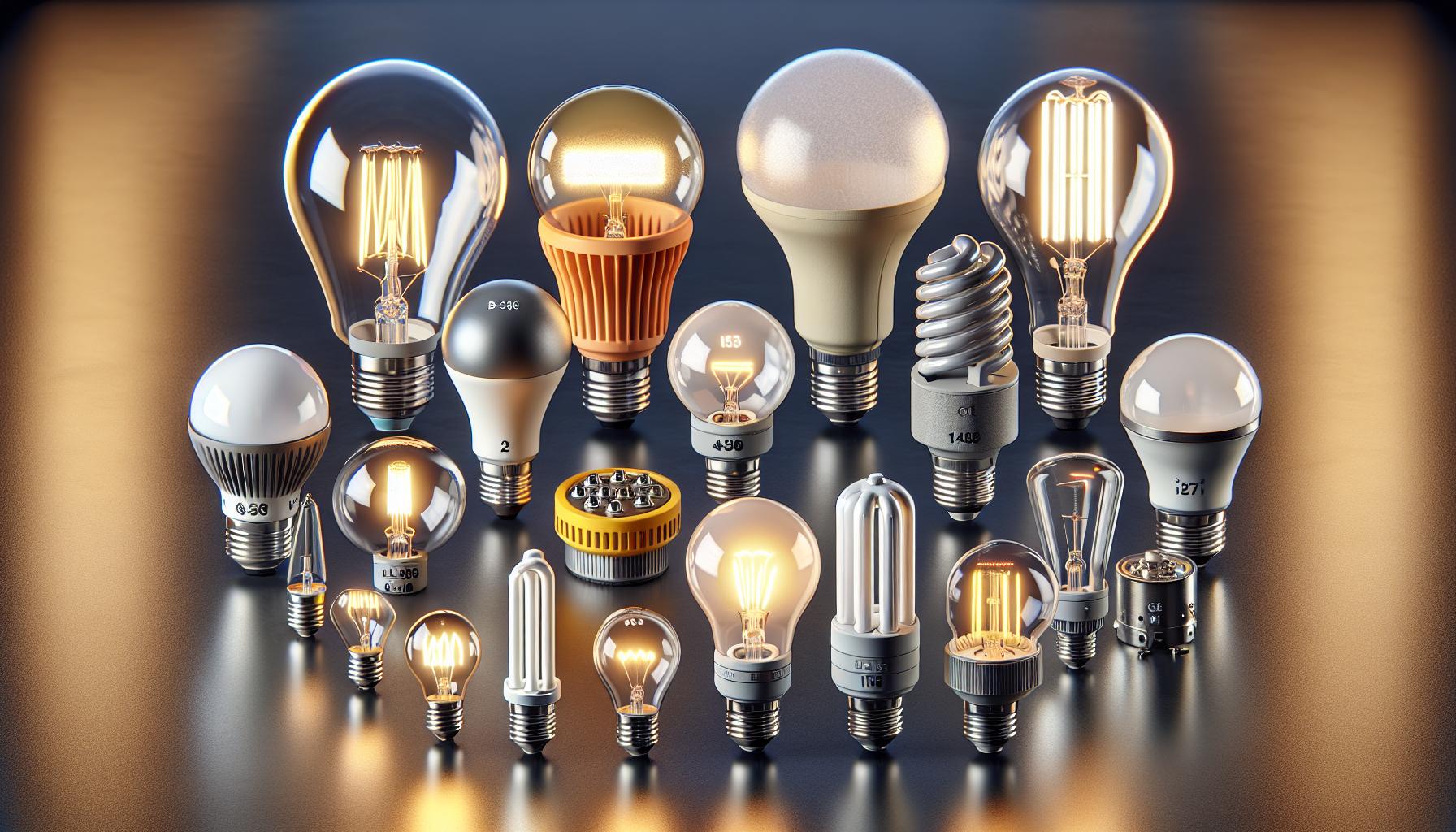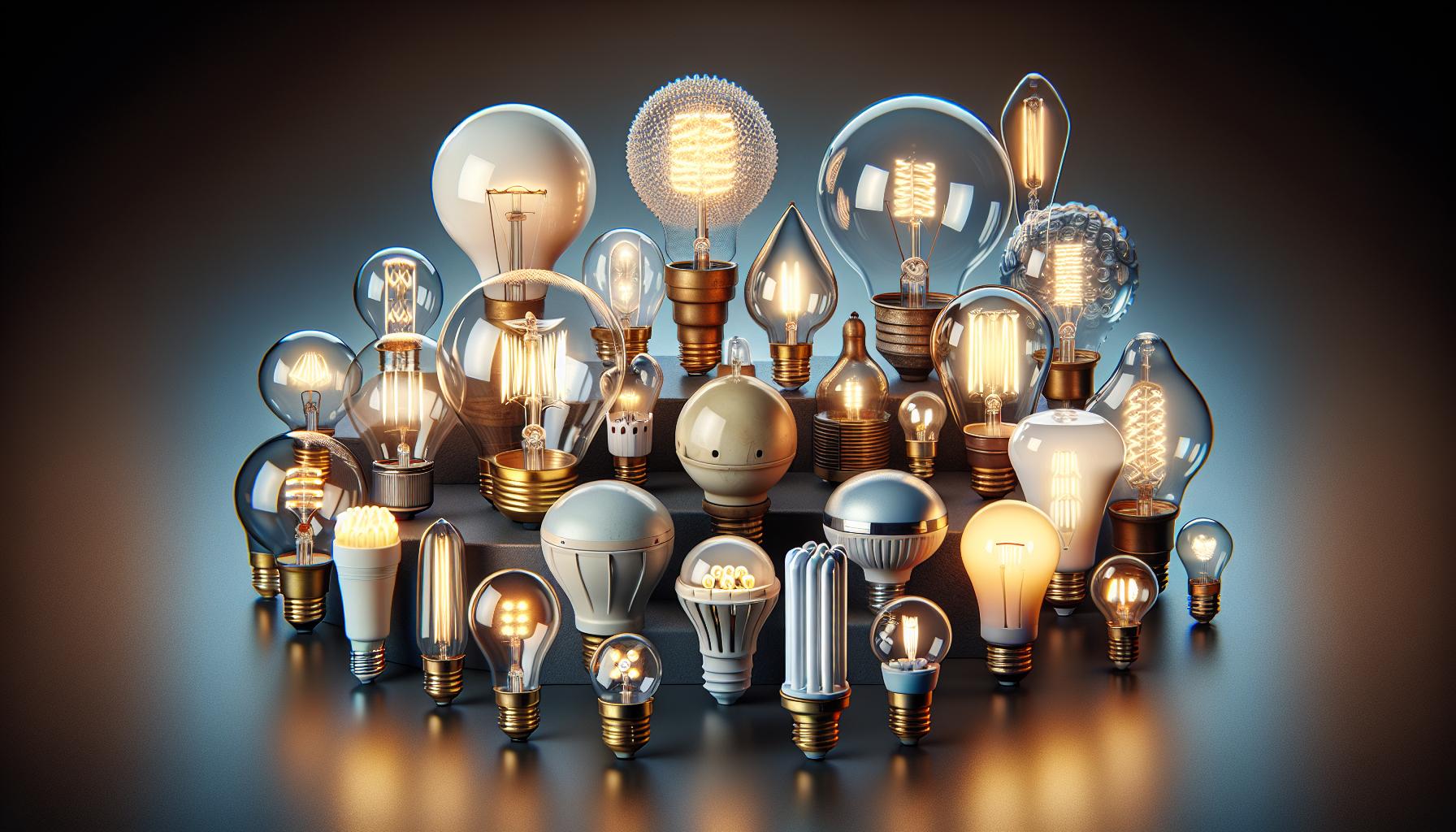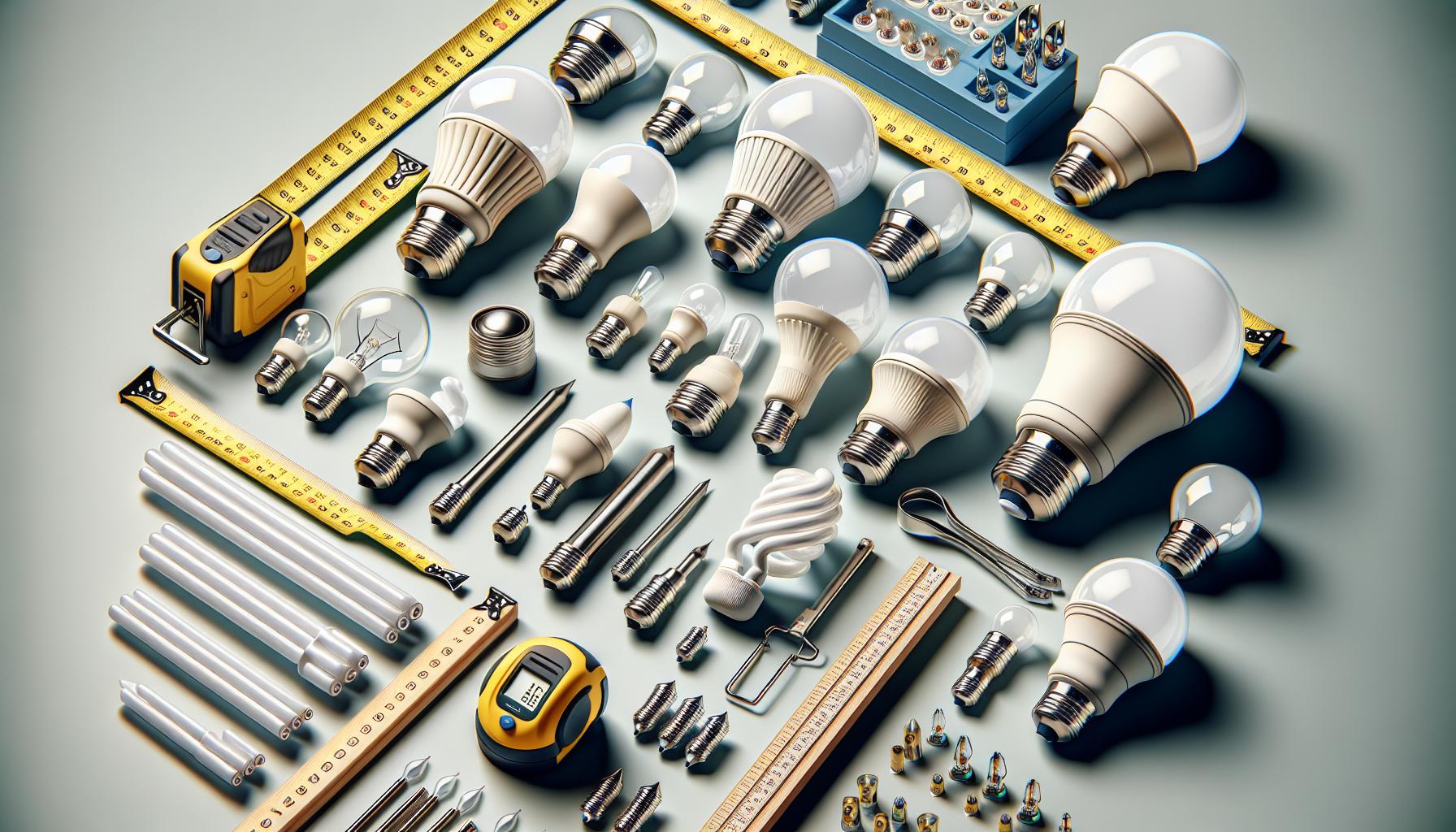Ever stood in the light bulb aisle, scratching your head, wondering if you’re about to grab the wrong size? You’re not alone. It’s a common misconception that all light bulbs are created equal when it comes to size. But here’s the deal: they’re not.
Why size matters when it comes to light bulbs
When you’re knee-deep in a DIY project, the last thing you want is to hit a snag because of something as seemingly trivial as a light bulb size. But here’s the deal: like shoes, light bulbs need to fit just right. If they don’t, the fixture won’t work as planned and your cozy reading nook or that vintage lamp you’re restoring might not shine.
Fitting the Fixture: You probably know that light bulbs come in a variety of shapes and sizes. From the classic A19 to the tubular T8s, each one has its own designated spot. Should you accidentally pick a bulb that’s too large or too small, you’ll face the inconvenience of a return trip to the store or, worse, a fixture that just won’t light up.
Light Distribution: Size influences how light is spread across a room. A bulb that’s too small may focus light in a narrow beam, failing to illuminate the space adequately. Conversely, a bulb that’s too big could provide too much light, overwhelming the room and washing out the ambiance you’re aiming for.
- Smaller bulbs are typically used for:
- Accent lighting
- Task lighting
- Larger bulbs are suited for:
- General lighting
- Outdoor spaces
Aesthetics: Let’s not forget the visual harmony of your room. A bulb protruding from a sleek, modern fixture can be an eyesore, disrupting the aesthetic you’ve worked hard to cultivate. On the flip side, a bulb too small may look dwarfed and silly, like a giraffe on roller skates.
From practicality to aesthetics, the size of your bulb integrates with the larger vision of your home design. Be discerning with the dimensions of your light bulbs, and they’ll slot into your overall plan like a dream. Next time you’re browsing the aisle or clicking through a website, remember that size isn’t just a detail—it’s a central piece of the lighting puzzle. Keep the specs handy, measure if you must, and always prioritize the right fit for the right function.
Different types of light bulb sizes
When you’re delving into the world of illumination, you’ll quickly discover that light bulbs come in a dazzling array of sizes. Selecting the perfect one isn’t just about wattage or brightness; it’s about fit, form, and function. Let’s shed some light on the most common types you’ll encounter.
Standard Bulb Sizes
In the United States, the two most prominent base sizes for household light bulbs are E26 and E12. E26 bulbs, also known as Medium or Standard bulbs, are your go-to size for most table lamps and ceiling fixtures. On the other hand, the E12 size, referred to as Candelabra, is more petite and often found in decorative fixtures and small lamps. They can add that touch of subtlety to your interior without overwhelming it.
Small to Large Specialty Sizes
- Miniature Bulbs: Ideal for low-light areas and small electronic devices. These tiny troopers often illuminate your cozy reading nooks.
- Tube Lights: Long and slender, these are a favorite for under-cabinet lighting or commercial settings. They distribute a clean line of light over workspaces and counters.
- Globe Bulbs: With a round, globe-like shape, they’re perfect for bathroom vanities and pendant lights. These bulbs add a modern flair wherever they’re used.
Measuring Up
When you’re out shopping for bulbs, remember to check the luminaire’s specifications. If you don’t grab your measuring tape, at least take note of the model number and dimensions listed on your old bulb. There’s nothing worse than bringing home a bulb that just doesn’t fit!
Reflectors and Spotlights
If you’re into home DIY projects, you’ve likely worked with reflector or spotlight bulbs. These bulbs, identified by codes like R20, BR30, or PAR38, are designed to focus light into a beam. They’re exceptional for highlighting artwork or washing walls with light in track lighting systems.
The various sizes mentioned above are just a glimpse into the expansive world of light bulbs. As a lighting enthusiast, you’ll find that there’s a bulb for nearly every socket and a size for every situation. The key is to know which bulb size is right for your specific need.
Standard light bulb sizes
When you’re knee-deep in a DIY home project, knowing the standard light bulb sizes can save you a trip back to the store. Picking out the perfect light bulb isn’t just about the base size; it’s also about the bulb’s shape and dimensions.
« Why Are LED Light Bulbs More Efficient? Uncover the Shocking Lifespan & Eco Benefits
Which Light Bulbs Are Most Energy Efficient? Discover the Best for Savings »
A-Series bulbs are what you probably picture when you think of a light bulb. The A19 is the standard size for most household lamps. This pear-shaped bulb is your go-to for general lighting. If you’re looking for something a bit bigger, you might need an A21.
In contrast, B-Series bulbs, often referred to as candelabra bulbs, come with a smaller E12 base. These bulbs are typically used in decorative lighting fixtures like chandeliers. They’re the elegantly shaped options that add a touch of class to any room.
Don’t forget about PAR bulbs—PAR stands for parabolic aluminized reflector. These are the robust, heavy-duty bulbs you’ll want for outdoor flood lights or indoor recessed cans. Designed to cast a directional light, PAR bulbs are measured in eighths of an inch, so a PAR38 bulb is 4.75 inches in diameter.
For table lamps or accent lighting, G-Series bulbs, or globe bulbs, provide an even, ambient glow. The larger surface area diffuses the light, reducing glare and creating a soft, welcoming atmosphere.
- A19: The standard household bulb size.
- B10: A common decorative bulb size, typically with an E12 base.
- PAR38: A frequent choice for flood lights, with a broader beam.
Keep in mind that these are just a snapshot of the common sizes you’ll encounter. Each series comes in various sizes to suit your specific lighting needs. Whether it’s a cozy reading nook or a lively kitchen, there’s a bulb size designed to fit your fixtures and your illumination preferences perfectly. Just make sure when you’re shopping, you have the fixture or old bulb in hand to match the size correctly.
Non-standard light bulb sizes
While you’ve learned about the common light bulb series, it’s important to note that not all bulbs fit into those neatly defined categories. In the world of lighting, there are also non-standard sizes that cater to unique or specialized fixtures. Exploring these can be particularly intriguing if you’re a fan of home DIY projects or if you love to light up your space in unconventional ways.
First off, you might come across miniature bulbs. These tiny lights are often found in appliances, electronics, or automotive lighting. They’re key for the places where a standard-size bulb just won’t fit, and they come in various shapes such as tubular, wedge, and even bi-pin designs.
Then there are antique and vintage-style bulbs, which have gained popularity thanks to their rustic charm. These bulbs are typically designed with exposed filaments that mimic the original Edison bulb design. They often feature irregular shapes or oversized glass that wouldn’t fit standard size classifications.
For those of you who are tech-savvy, smart bulbs have entered the scene with shapes that deviate from the norm. They go beyond illumination by offering features such as color-changing capabilities, dimming without a separate switch, and connectivity to smart home systems. Due to their electronic components, these bulbs sometimes have larger bases or different shapes to accommodate the tech inside.
Lastly, in specialized industrial or scientific settings, you may find a host of other non-standard sizes. These bulbs aren’t usually sold in regular home improvement stores and may require ordering from specific suppliers.
Remember, when you’re venturing into the realm of non-standard bulb sizes, it’s especially crucial to know the specifications of your fixture. Accurate measurements and a clear understanding of the bulb’s purpose will guide you to the right choice. Whether it be for an intimate reading nook or to achieve that warm vintage aesthetic, there’s a bulb out there that’s a perfect fit.
Choosing the right size light bulb for your fixture
When you’re in the middle of a home DIY lighting project, nothing can be as frustrating as choosing a light bulb that doesn’t quite fit. Ensuring the right fit for your light fixture is as crucial as selecting the style or wattage. Many fixtures require bulbs of a specific size, not just in width or height, but also in terms of the bulb’s base.
First up, check the lamp or fixture for any markings indicating the maximum bulb wattage and the size needed. This step is critical. Ignoring wattage limits can pose a fire hazard, while the wrong size can lead to poor illumination or even damage to the fixture. To be on the safe side, always follow the manufacturer’s specifications.
Next, let’s talk about the base of the bulb. Bases such as E26 are common in the United States and fit what’s considered a standard light socket. However, other fixtures might require different base sizes like the E12, also known as a candelabra base, which is typically found in decorative lighting fixtures. If you’re replacing a bulb, the easiest method is to bring the old one with you when shopping. Here’s a quick rundown of common base sizes:
- E26: Standard base for most fixtures
- E12: Candelabra base for chandeliers and decorative lamps
- E10: Miniature base, often used in flashlights and small electronics
- GU10: Twist-and-lock base, commonly found in recessed or track lighting
For fit, you’ll be dealing with the dimensions of the bulb. A19 shapes are standard for household use, but a larger or smaller fixture might require something like an A21 or A15 bulb, respectively. Always measure the fixture’s opening if you’re unsure. Bulbs that are too wide can cause overheating, while too narrow bulbs may dim the potential brilliance of your lighting design.
Understanding lumens and brightness is also key. Higher lumens mean a brighter light. If you’re looking for a cozy, warm feel, lower lumens paired with a warmer color temperature might be your ideal choice. With advancements in LED technology, you can now have high-lumen output without the high wattage, which is easier on your electric bill and the environment.
Conclusion
So you’ve got the scoop on light bulb sizes and why they matter for your space. Remember to match the bulb to your fixture’s requirements and keep those lumens in mind for the perfect brightness. With LED advancements, you’re no longer limited by wattage, so you can light up your home efficiently. Next time you’re bulb shopping, you’ll know exactly what to look for. Happy lighting!
Frequently Asked Questions
What is the importance of choosing the right size light bulb for my fixture?
Choosing the correct size ensures that the bulb fits properly in the fixture, provides the right amount of illumination, and operates safely without overheating.
How can I determine the maximum bulb wattage for my lamp or fixture?
Check for any markings on the lamp or fixture indicating the maximum wattage recommended by the manufacturer, and always adhere to these specifications for safety.
What are common base sizes for light bulbs?
The most common light bulb base sizes are E26 for standard fixtures and E12 for small, decorative lighting fixtures.
Why is it important to measure the fixture’s opening before selecting a bulb?
Measuring the fixture’s opening ensures the new bulb will fit snugly and function correctly without being obstructed or loose.
How do lumens relate to brightness?
Lumens measure the amount of light emitted by a bulb, with higher lumens indicating greater brightness. It’s essential to understand lumens to choose a bulb that provides the desired level of brightness.
Do LED bulbs offer high brightness with low wattage?
Yes, advancements in LED technology provide high-lumen output bulbs that are bright without requiring high wattage, making them energy-efficient choices.





